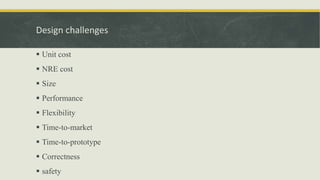Design challenges in embedded systems
- 1. Design Challenges in Embedded Systems G. Mahalakshmi Malini, AP/ECE Avinashilingam Institute for Home Science and Higher Education for Women, School of Engineering Department of Electronics and Communication Engineering
- 2. Challenges faced during embedded system design: Type and amount of hardware needed. Optimising the power dissipation and energy consumption Process deadlines Flexibility and ability to upgrade Reliability
- 3. Challenges in embedded system design Type and amount of hardware Hardware based on SoC or VLSI design has very high NRE cost and hardware design on a circuit board depends on available chips. Power dissipation Power is energy dissipated per second Energy Consumption Energy consumption per unit talk time in a phone needs to be controlled so that battery requires 24-hour battery charging after the 4 hours of talk during the day. Process deadlines Meeting the deadline of all processes in the system while keeping the memory, power dissipation, processor clock rate and cost at minimum is a challenge. Flexibility Flexibility in design at little cost overhead is a challenge. Ability to upgrade Ability to upgrade the design while keeping the cost minimum
- 4. Challenges in Embedded Challenges in Embedded System Design: Optimizing the Design System Design: Optimizing the Design Metrics Power dissipation, physical size, number of gates and engineering, prototype development and manufacturing costs.
- 5. Design challenges Unit cost NRE cost Size Performance Flexibility Time-to-market Time-to-prototype Correctness safety
- 6. Unit cost and NRE cost Unit Cost: the monetary cost of manufacturing each copy of the system, excluding NRE cost. NRE cost (Non-Recurring engineering cost): the one-time monetary cost of designing the system.
- 7. size The physical space required by the system Individually or part of a system
- 8. Cost and type of hardware needed Optimizing the microprocessors, ASIPs and single purpose processors in the system. Hardware software participation How much H/W How much S/W? Optimization – according to the performance, power dissipation, cost and other design metrics the system.
- 9. Optimizing hardware (memory RAM, ROM or internal and external flash or secondary memory in the system, peripherals and devices internal and external to the system, ports and buses in the system and power source or battery in the system)
- 10. Considering design metrics Power dissipation Physical size, number of gates and engineering Prototype development and manufacturing costs.
- 11. Power dissipation optimizing Clock rate reduction Operating voltage reduction Wait, stop and cache disable instructions Disabling or controlling certain units when not needed is one method of saving power during execution. Small size, low weight Real time/ reactive operation
- 12. Deadlines Challenging is reducing cost by meeting the deadline of all processes in the system while keeping the memory, power dissipation, processor clock rate.
- 13. Flexibility Different versions of a product for marketing The ability to change the functionality of the system without incurring heavy NRE cost Upgrading and releasing advanced versions
- 14. Reliability and safety Designing reliable product Testing, verification and validation is a challenge Assured safety
- 15. Testing Find errors and to validate that the implemented product is as per the specifications and requirements to get reliable product.
- 16. verification Ensure specific functions are correctly implemented
- 17. Time-to-prototype, Time-to-market The time needed to build a working version of the system. The time required to develop a system to the point that it can be released and sold to customers.
- 18. Maintainability The ability to modify the system after its initial release Correctness, safety
- 19. Validation To ensure that the system that has been created is a s per requirements agreed upon at the analysis phase, and to ensure its quality
- 20. Summary Discussed the different challenges in embedded system design Explained the need for optimization in design and production Discussed the importance of power utilization and minimization



















